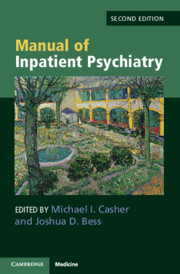Book contents
- Manual of Inpatient Psychiatry
- Manual of Inpatient Psychiatry
- Copyright page
- Contents
- Contributors
- Preface to the Second Edition
- Foreword: American Inpatient Psychiatry in Historical Perspective
- Chapter 1 The Inpatient with Schizophrenia
- Chapter 2 The Inpatient with Depression
- Chapter 3 The Inpatient with Mania
- Chapter 4 The Inpatient with Borderline Personality Disorder
- Chapter 5 The Inpatient with Dementia
- Chapter 6 The Inpatient with Traumatic Brain Injury
- Chapter 7 The Inpatient with Dual Diagnosis (Co-Occurring Disorder)
- Chapter 8 The Young Adult on the Inpatient Unit
- Chapter 9 Clinical Documentation on the Inpatient Unit
- Index
- References
Chapter 7 - The Inpatient with Dual Diagnosis (Co-Occurring Disorder)
Published online by Cambridge University Press: 05 March 2020
- Manual of Inpatient Psychiatry
- Manual of Inpatient Psychiatry
- Copyright page
- Contents
- Contributors
- Preface to the Second Edition
- Foreword: American Inpatient Psychiatry in Historical Perspective
- Chapter 1 The Inpatient with Schizophrenia
- Chapter 2 The Inpatient with Depression
- Chapter 3 The Inpatient with Mania
- Chapter 4 The Inpatient with Borderline Personality Disorder
- Chapter 5 The Inpatient with Dementia
- Chapter 6 The Inpatient with Traumatic Brain Injury
- Chapter 7 The Inpatient with Dual Diagnosis (Co-Occurring Disorder)
- Chapter 8 The Young Adult on the Inpatient Unit
- Chapter 9 Clinical Documentation on the Inpatient Unit
- Index
- References
Summary
First, a clarification of vocabulary is needed. In this chapter, the terms “dual diagnosis,” “substance use disorder[s],” “[name of substance] use,” and/or “[name of substance] dependence” are used. The more modern term “co-occurring disorder” is virtually synonymous with “dual diagnosis,” both of which reference the coexistence of a clinically significant use of drugs and/or alcohol with a primary psychiatric illness (an example of this would be bipolar disorder with cocaine dependence). Of course, a patient can have a substance use disorder (SUD) without having a dual diagnosis – i.e., without a separate, primary psychiatric illness [1]. The assumption is made that, unless mentioned specifically, clinical situations discussed here involve patients who do have a primary psychiatric illness in addition to a SUD. Also, although the fairly recent, though now outdated, DSM-IV criteria differentiated between substance abuse and substance dependence, this volume (again, unless specifically mentioned) does not make that distinction.
- Type
- Chapter
- Information
- Manual of Inpatient Psychiatry , pp. 142 - 161Publisher: Cambridge University PressPrint publication year: 2020



